Here on The Fandomentals we like to talk about Avatar: the Last Airbender (ATLA) and its sequel, Avatar: the Legend of Korra (LoK). But while many of us have talked about the strides the franchise has made in LGBT representation, its portrayal of a mental healing and recovery, complicated family dynamics or deconstruction of the superman narrative, I would instead talk about something that has concerned me ever since I saw the second season of Legend of Korra: spirits. After all these years, it’s time to finally put my concerns into words. And I will unfortunately continue to be the resident malcontent when it comes to the show.
To start with, let me lay down some groundwork and my central thesis. See, there’s two ways that the word “spirituality” is used in the franchise. One is the meaning we associate with it in the real world – concerned with immaterial things rather than material ones, inward-looking, meditative, contemplative. The other is the setting-specific meaning of being connected with the spirits and their world. But here’s the rub – the spirits aren’t actually very spiritual. Why do I say that? Let’s begin…
Avatar: the Last Airbender
Spirits certainly exist in the world the original show portrays, but they only sometimes play any major role – the biggest is perhaps the Book One finale. They’ve got their own worlds, but they also have a rather vague relationship with nature. In “Winter Solstice” we see a spirit named Hei Bai go mad after humans devastated a forest.
Vague it may be, it’s also significant, as we find out during “Siege of the North”. Zhao killing the Moon Spirit causes the moon itself to grow red and waterbending to stop working. If Yue hadn’t become a new Moon Spirit, presumably it would have become even worse from there.
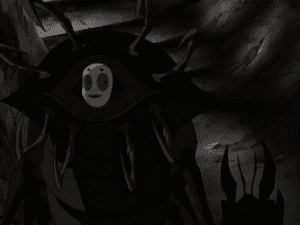 In the same finale we also meet Koh the Face-Stealer, a spirit whose brief appearance nonetheless made him memorable. Just as his name implies, he steals faces, and the only defense is to maintain an entirely neutral, emotionless expression. This is the kind of thing that spirit stories tend to run on, after all – taboos and specific behavior that protect you from malevolent spirits. He was genuinely creepy and threatening in what little we saw of him.
In the same finale we also meet Koh the Face-Stealer, a spirit whose brief appearance nonetheless made him memorable. Just as his name implies, he steals faces, and the only defense is to maintain an entirely neutral, emotionless expression. This is the kind of thing that spirit stories tend to run on, after all – taboos and specific behavior that protect you from malevolent spirits. He was genuinely creepy and threatening in what little we saw of him.
The other spirit who plays a major role is Wan Shi Tong, the cranky owl who runs the spirit library. He accuses humans of always trying to use his knowledge for their own brutal ends. In his defense, Zhao used the library to find out about the Moon Spirit’s physical form, and we know how that 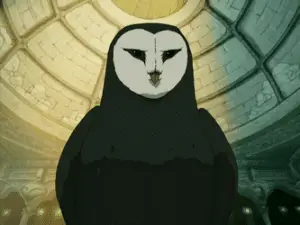 ended up.
ended up.
The Painted Lady only appears very briefly, after the rest of the episode might make us suspect she doesn’t actually exist. Like Hei Bai and the Moon and Ocean spirits, she has a connection to the natural environment, in this case her lake.
The show’s finale involves Aang receiving energy-bending from a Lion-Turtle, but… are they spirits? It’s kind of ambiguous what they are, what they aren’t and what they want. Still, they clearly do have some spiritual connections and they allow Aang to resolve the conflict without compromising his beliefs… even though the way they do it leaves something to be desired.
Spirits are, in general, the more outwardly “magical” element of the world in Avatar: The Last Airbender. Bending is by design rather predictable and we generally know what works and what doesn’t by the time we’ve seen half of the first season. Spirits introduce stranger and more fantastical things with them when they appear, but they’re not particularly central.
Legend of Korra Book One
The first book of the sequel contains no spirits. Amon says that they sent him to bring balance to the world, but he’s lying. So none of them appear or do anything. However, the word “spiritual” crops up frequently, mostly in terms of Korra’s lack of this trait. But why is she lacking in it and why is it a problem?
Well… that’s a good question, actually. “Not spiritual enough” seems to be a catch-all term for Korra’s struggles with airbending, connecting to her past lives, entering the Avatar State and her general combative attitude that focused on fighting and bending rather than the Avatar’s duties as a leader. Basically, every character flaw and struggle the show outlines for her.
Unfortunately, as we know, none of it really goes anywhere. Korra receives her vision from Aang long after it ceases to be useful, her airbending comes to her when Mako is in danger and she connects to her “spiritual side” because she’s depressed. This moment is just the first of many where the word “spiritual” is thrown around without any meaning. She became more “spiritual” in the sense that she got access to all her Avatar powers, but she gained no spirituality in the other sense of the word.
Sadly enough, you can see some ultimately unused plot hooks in this story. Korra receives her first incomplete vision of Yakone’s trial after Amon knocks her out during their “premature” confrontation. She receives her second vision after Tarrlok bloodbends her into unconsciousness and the final, complete one when he holds her hostage. It seems clear that Amon also used bloodbending on her, but subtly and maybe in combination with chi-blocking. Thus opening a way for Korra to figure it out on her own. But that was not to be and instead all the relevant information came from Tarrlok’s exposition dump.
But let’s not dwell on it too much. Instead, let’s move on to the second season, where spirits come to the fore.
Legend of Korra Book Two
And they do so in style, by attacking right in the first episode. The dark spirits prove difficult for even strong benders like Korra, Tonraq, and Tenzin to handle. Non-benders are entirely helpless, even though we saw Sokka best Wan Shi Tong with a heavy book and gravity. This is in keeping with LoK’s treatment of non-benders, really. We also find out there’s some tensions between spirits and humans and that corrupt spirits attack more and more often.
Either way, Korra’s uncle, Chief “I’m not a villain, I swear” Unalaq pacifies the spirit with a waterbending technique. Korra is impressed and wants to learn from him, since she feels she’s not spiritual enough to be the Avatar and a bridge between worlds. Sensible, one might think, and a logical progression. And yet… something doesn’t add up.
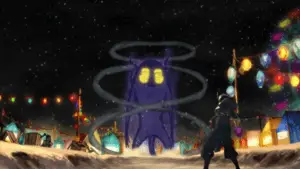
It once again comes down to the issue of spirituality and actual spirits. Unalaq complains about how the Southern Water Tribe turned their spirit festival into a festival of commerce. Which sounds plausible on the surface. He’s a crusty old traditionalist, of course he’ll complain about it. But what do the sprits even care? It’s not as if they have any concept of economy. As long as humans don’t go around destroying the environment or infringing on “spiritual” places (not that we know what makes a place qualify as such), they seem to be indifferent. Korra’s father, Tonraq, got on their bad side by doing the latter.
I feel like the show sort of expects us to take it as face value – they call it spiritual, so obviously spirits should care, right? But real-world religions give a reason why the spirits or deities they believe in care about the ceremonies and rituals. Here, we see no such reason.
As I mentioned at the beginning, ATLA got around spirits by being pretty vague about them. They do spirit-y things, they get angry if humans mess around with things they shouldn’t, they have a connection to nature… in the end, they’re not what’s important. But the second season of Legend of Korra puts them front and centre and makes them tangible… well not literally tangible, but much more real and relevant.
It doesn’t exactly get better when it turns out that Unalaq– who is absolutely not a villain, trust him on that– arranged for Tonraq to destroy a spirit-grove in the first place. Later on, it further turns out that he’s working with the spirit of darkness. It’s the two of them together that are responsible for the dark spirits attacking people. Which means… there’s no actual tension between humans and spirits, no crisis of spirituality or anything of the sort. Just two bad guys doing bad guy things.
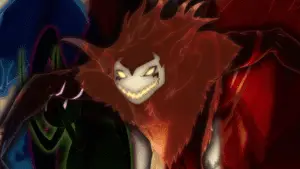
Or… not exactly. After Unalaq spent many episodes doing various terrible deeds, and competing with Hiroshi for the title of the franchise’s second-worst father, he asks Korra if Avatar Wan had done the right thing when he separated the worlds. So it suddenly becomes a question we’re meant to care about. The relations between spirits and humans become an actual topic rather than just Vaatu being a big evil kite. But this happens right before the finale, so there’s not much time to talk about it.
As we know, Korra agrees. Why? Good question. The decision to keep the portals open gave her agency that the Book One finale had never given her. Her becoming the first Avatar of a new age is also appropriate. But as far as motivations and sense go… well, it has none. Which brings me to the second massive problem with the spirits in the show, and requires me to start at the “Beginnings”.
In the two-parter we see humans and spirits living in the same world. Or rather, humans surviving seemingly thanks to the protection of the Lion-Turtles. Everything beyond the four settlements huddling on their shells is a hostile jungle full of spirits who won’t give them an inch. We see proto-firebenders go out to hunt using their power. Again, the only reason they can do even that is because the Lion-Turtles help them. Why? Like I’ve said a few times already, good question. But one we have no answer for.
When Wan is exiled from his town and ventures into the wilds, he earns the spirits’ trust by not eating a gazelle he encounters. Which… well, I suppose gets us into the whole argument about whether or not it’s moral to eat meat. But still, he had to risk starvation for them to give him a chance? This starts the general trend in which it’s humans who have to put all the effort into harmony between the two species.
We do later see that there was a tribe of proto-airbenders who live in harmony with the spirits. But how? Once again… good question, no answer. There’s really nothing here except a vague feel-good “spirits are great” message.
After Wan accidentally frees Vaatu, he later fuses with Raava permanently to fight him, becoming the first Avatar. He seals Vaatu into a tree and decides to forever separate the world. Which… isn’t a perfect solution, perhaps, but certainly looked better than what was, at best, a perpetual war. At worst, it was spirits oppressing and bullying humans. So why are we supposed to believe that this wasn’t the right choice and that the one Korra made was right?
![]()
Aside from the spirits’ behavior, there’s still the major disconnects between them and being “spiritual”. We still don’t really know what it means. Yes, Korra is woefully unequipped to deal with spirits. But that’s just part of her general immaturity and rashness at this stage of her character arc.
Tenzin, her mentor, is however also unable to mediate into the Spirit World. For… some reason. It seems connected to his general psychological turmoil and massive pressure he’s under to live up to his father’s expectations. The Spirit World is governed by human emotion, so I suppose it would make sense.
While the inability to enter the Spirit World this way is yet another failure dropped on the large pile of Tenzin’s issues, his daughter Jinora can do it. Once again, we don’t really know why Tenzin can’t do it, but she can. All we get is that, you guessed it, she’s more spiritual. Except we still don’t know what that means and why being spiritual is even of any concern.
I’m also not entirely sure why only benders seem able to enter the Spirit World through meditation. If we accept that it requires peace of mind, concentration and inner balance, non-benders are as capable of them all as benders are.
When Korra actually enters the Spirit World, it turns out to be a realm where reality is something of a subjective matter. Human emotions affect it, particularly those of the Avatar. It more or less adds up, is visually interesting and makes some intuitive sense. Still, I’m not sure how much it adds up with the spirits’ connection to the environment that we saw in ATLA.
We also see Iroh in the Spirit World, which raises the question of whether human souls end up there after death. We know the Avatar reincarnates into new bodies every time, but what about everyone else? Maybe Iroh was special – “spiritual” enough to transcend into the Spirit World after death.
This kind of exemplifies the problem I’m talking about here. Yes, Iroh was spiritual in ATLA, in the more conventional sense of the word. There were some hints that he’d travelled to the Spirit World, but for the most part his spirituality was very down-to-earth. He told Zuko to look at what’s in front of him and think about what he wants, instead of chasing some lofty destiny someone else had imagined for him.
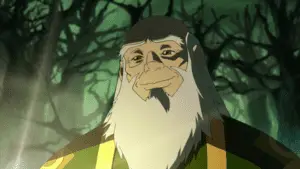
The wisdom of spirit-Iroh in Legend of Korra feels a lot like platitudes. Light, dark, staying true to yourself and all that. There’s just not much to it. His earthly wisdom and vague mentions of having had dealings with spirits are turned into some sort of deep connection to the spirits. Which allowed him to effectively become one.
What it adds up to is that the season tries to build up to Korra keeping the portal open, but the attempts just don’t work together. We don’t have a clear idea of what the relationship between humans and spirits should be. Korra’s decision feels like a big plunge for no good reason.
Legend of Korra Books Three and Four
The first episodes of Book Three deal with the consequences of the worlds reuniting. Korra spends a lot of time trying to contain the spirit-vines growing in Republic City, with the help of her friends. And the spirits… well, they don’t do a thing about it except yell at Korra, as if Raiko and the press weren’t enough. It seems that, once again, it falls to humans to work for harmony and peace, while the spirits are just going to complain about everything they do.
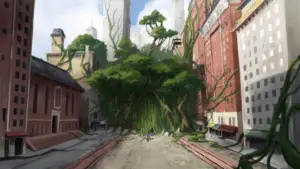
The spirits themselves take a backseat as Korra has to contend with the Red Lotus, so she never gets the chance to properly solve the problem. Which instead happens off-screen – we find out that in the period between Books Three and Four, while Korra was recovering from the horrific beating she took from the Red Lotus, Republic City integrated the Spirit Wilds. We see no real evidence of the spirits doing anything to help here, but at least they didn’t get in the way, I suppose?
Still, when Korra goes to ask for their help with Kuvira, she gets the cold shoulder. Kuriva is abusing the spirit vines to power her weapon and she’s invading the city where spirits and humans live together. But what do the spirits say? They’re not going to help, since they don’t interfere with human matters. But aren’t spirits and humans supposed to live together now, so there’s no “human matters” and “spirit matters” anymore? The worlds are back together and they’re all in it together, aren’t they?
I feel like it’s pretty common that whenever humans and more supernatural beings are in conflict in stories, the pressure is on humans to do something about and find common ground. The others, in this case spirits, are seemingly allowed to be aloof or outright hostile instead.
And of course it bears mentioning that humans have a lot more to fear from spirits than the other way around. They can hurt humans in many ways, while humans struggle to retaliate or attack. The biggest danger spirits seem to suffer from humans is their tendency to twist and corrupt when around humans who feel strong negative emotions.
To bring it all to the central point, I think the treatment of spirits in the Avatar franchise is one of the cases where a previously vague and ambiguous element gets more attention. Which doesn’t serve it well. Legend of Korra seems to expect us to take a lot at face value. It’s a lot of talk about spirits, spirituality, change and harmony without a whole lot to back it up. I got the distinct impression the show just skips over it all so we don’t have time to think about it too hard.

